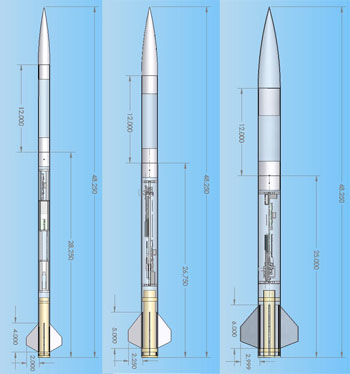History
There have been three generations of rockets developed and used in E80. The fourth is currently in design. The flight hardware has evolved through a learning process. When we first envisioned this course, we had not been directly involved in hobby and small-scale rocketry for some time. We had hoped to use the least expensive rockets that would fly with D- and E-sized motors. After consulting with Greg Lyzenga in Physics and contemplating the survivability of $1000 worth of avionics in a $20 rocket, we decided to investigate more upscale rockets. Initially Public Missiles, Ltd. with their Quantum™ tubing seemed to be the best option. Accordingly we bought six PML rockets and assorted body tubes for testing purposes. They are listed in Table 2.
| Rocket | Dia. (in) | Length (in) | Payload length (in) | Weight (oz) | 1000 ft motor |
| AMRAAM-2 | 2.1 | 42 | 24 | F25W | |
| MR-1 | 2.1 | 25 | 24 | F50T | |
| Phobos | 2.1 | 57.5 | 12 | 32 | G38BM |
| Quasar | 2.56 | 56.2 | 9 | 39 | G80T |
| D-Region Tomahawk | 3 | 71 | 21 | 55 | H55W |
| 1/4 Scale Patriot | 3.9 | 55.7 | 9 | 50 | H55W |
After the test flight of Mudd I, we switched from the PML kits towards custom-built carbon fiber or kevlar rockets. The D-Region Tomahawk we used for Mudd I performed admirably and reached just under 1000 ft with an H-series motor, but the difficulty of incorporating the avionics, sensors, and ejection system into the kit led us to believe that the custom rockets would give us easier manufacturability and lower weight for better performance.
Mudd II was constructed from carbon fiber to test manufacturability and evaluate the performance of the sensors on a carbon-fiber rocket. The rocket flew well, but it was far too heavy for the course rockets (we had hoped for 1000 feet on a "G") and it proved far too stiff and absorption damping. With a gain of 10 higher than Mudd I the vibration sensors barely registered on the 10-bit DACs on the R-DAS used for flight measurements. Mudd II had two successful flights that exceeded Mach 1 and reached altitudes of almost 9000 feet AGL. Its final flight in June 2008 was an unsuccessful attempt to reach 14,000 feet AGL. It suffered a catastrophic event 2.6 seconds into the flight at about Mach 1.6. The avionics section and the motor section were recovered, but the parachutes, the nose cone, and two of the fins were never found.
The Mudd III design was in direct response to the lessons learned from Mudd II. There were three designs differing in diameter but all of approximately the same length: Mudd IIIA, Mudd IIIB, and Mudd IIIC, also known as Small, Medium, and Large. Given the funding constraints, there were only two Mudd IIIAs constructed, and three each of the Mudd IIIBs and Mudd IIICs. They were flown by the students at the end-of-semester launches in 2008. The Mudd IIIAs suffered from a fatal design flaw. A single battery powered both the video camera and the R-DAS recovery system. The total current draw exceeded what the battery could handle and both rockets failed to detect apogee and fire ejection charges. Most of the avionics were recovered relatively undamaged, but both rockets suffered irreparable structural damage. The remaining rockets performed well in flight, but the ease of accessing the avionics, the turnaround time between flights, and the altitudes achieveable on 120 Ns motors were all below expectations.
The Mudd IV design, currently in progress, aims to address the avionics access, turnaround time, and altitude issues. We have gone through several iterations while looking at several different issues. The present design (which we hope to refine and not change radically) uses thin inner and outer shells of kevlar composite with polyurethan foam in between. The fins are carbon composite. The avionics bay will have a large connector on the bottom with leads to all of the sensors and other connections. The construction process and sensor installation are also being optimized. A finished rocket should be able to be completely disassembled in about five minutes, and be fully assembled and prepped for launch in about ten minutes (including motor loading, but not motor assembly time). We are only designing one size of Mudd IV instead of three due to resource constraints. We've decided it's better to have one fully-optimized rocket, rather than three poorly-designed rockets.
In response to the student desire to get their hands dirty and actually make a rocket, and the desire to fly something right away, we are adding a commercial quick-assembly kit. The Quest E-Z Payloader will be assembled and modified during the first evening lab session, and then flown with a C6-5 motor and a PerfectFlite Alt15K/WD Rev2 altimeter the next afternoon. The E-Z Payloader doesn't require FAA approval so can be flown close to campus, and the 1 foot resolution of the Alt15K will permit the students to massage the altitude data to get velocity and acceleration (with appropriate numerical tricks).
We had hoped that the Mudd IV – E-Z Payloader combo would be robust enough that we wouldn't have to touch rocket design again for another five years. Such hope was vain.


